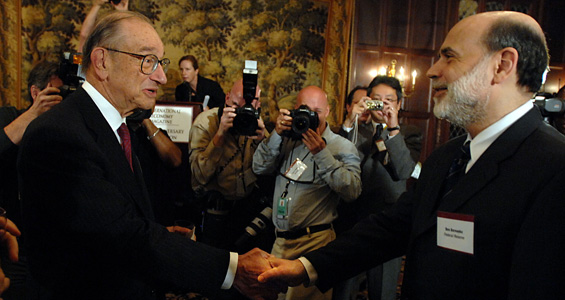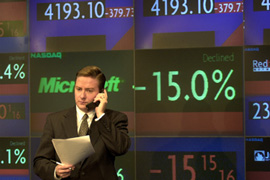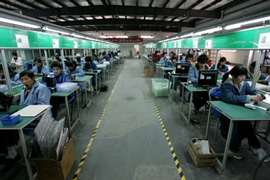The Bubble Decade
The economic ups and downs have put more of a signature on 2000-09 than other events.

 |
| Bernanke, right, seen here with Alan Greenspan, former chairman of the Federal Reserve, could be credited for saving the US by his activism in the last year of the decade [GALLO/GETTY] |
It is befitting that Time magazine made Bernard Bernanke, the chairman of the Federal Reserve, the US central bank, as its “Man of the Year” for 2009.
Surely, the decade of 2000-09 will go down in history as the decade of the forming and bursting of one of the biggest financial bubbles ever.
Though this was the decade of 9/11, followed by the US invasions of Afghanistan and Iraq, the economic ups and downs may have put more of a signature on the decade 2000-09 than even those world-altering events.
The decade of 2000-09 began with an economic smarting due to the dissipation of the personal computer-internet boom.
The PC-internet boom was a major technological epoch covering more than the previous decade.
It had brought about high and sustained economic growth to the US and most of the world. But by 2000, not only was the technological epoch over, but the financial bubble that had accompanied the real growth had also burst.
As the US economy was floundering around aimlessly, the only policy issue being talked about was the Bush tax cuts, which once implemented transformed the US government’s annual budgets from surpluses to deficits.
And then came 9/11. Wall Street crashed in the ensuing days, and there was a serious concern that the US would go into a downturn.
 |
| The artificial US housing boom in early 2000 led to the financial crisis [GALLO/GETTY] |
In response, the Fed [the US federal bank] under Alan Greenspan started creating money at an unusually high rate.
This brought the Fed’s lending rate to commercial banks to one per cent and sometimes even below.
The Fed continued to pump money into the banking system for a long period of time, making it one of the longest binges of money creation in it’s history.
Where was all this liquidity supposed to go? As mentioned before, there was nothing happening in the real economy once the PC-internet boom was over.
Most of this money found its way into the real estate sector, and by 2003 a real estate boom had begun in the US.
The boom was not driven by construction as it was in China, India and Dubai, but mostly by Americans turning over the existing stock of housing among each other.
This artificial boom was the cause of the financial crisis in the latter part of the decade.
Real growth
However, while financial booms were the order of the day in the US, and as we shall explain below also in western Europe, most of the rest of the world was enjoying real economic growth.
China, which had already achieved 10 per cent growth rates of GDP in the1990s, continued its turbo-charged growth rates into the first decade of the 21st century.
What was really new in this decade was that even India managed to raise its growth rates to about 7-8 per cent per annum.
While South Korea did not have the same high growth rates as China and India(having had its share in the 1990s), it recovered rapidly from the so-called East Asian Financial Crisis of 1998, and established itself as a leading manufacturer of high-end industrial products.
The rest of East and South-East Asia also did very well, with Vietnam achieving high enough growth rates to herald itself as yet another successful newly emerging country from that region.
Even Indonesia, the fourth-most populous country in the world, finally recovered from the east Asian crisis and achieved high growth rates.
In Asia, only Japan stagnated, or worse still, declined.
Good news came from many sources. In fulfillment of our hopes and wishes, sub-Saharan Africa started growing at an average annual rate of 5 per cent, outperforming their population growth rate of 2 per cent.
The Aids situation in Africa started improving thanks to the efforts of many: the WTO; the US and European governments; pharmaceutical companies from not only the West, but also from Brazil and India; private charitable trusts like the Bill Gates and the Clinton foundations; and several others.
Latin America also poised itself for economic “take-off”. Brazil, under the new leadership of Lula, laid the foundation for the latest economic miracle – the unfolding of which we are witnessing now, and will most definitely continue into years to come.
The Middle East, especially the oil and natural gas exporting countries, performed remarkably well too. Qatar, for instance, became one of the richest countries in the world.
It also became evident that the Russian economy’s performance was also tied to the price of oil.
 |
| China’s economic growth was ‘turbo charged’ this decade [GALLO/GETTY] |
The oil-exporting countries were buoyed both by the world-wide real economic growths and also by the financial mania that started from the US financial sector and infected the oil futures markets, resulting in the orgy of speculation which drove the price of a barrel of oil up to $140 in spite of Opec’s publicised desire to keep the price of a barrel at $70.
The speculators in the oil futures were the same entities who were betting in the real estate markets – Goldman Sachs, for example.
The insane rise in the price of oil did some real damage to the world economy.
The precipitous rise in the cost of jet fuel bode disasters for many airlines companies.
In the US, this artificial rise in the price of oil put the last nail in the coffin of General Motors, which had mistakenly bet on gas guzzlers like many models of SUVs and the unforgettable “in your face” Hummer.
However, the speculative mania of the last decade took the strongest hold in Dubai. The emirate came to represent the worst aspects of economic activities which took inordinate risks with cheap money.
Regional economic integrations made a lot of news in the last decade. The European Union (EU) kept on expanding in membership, but more importantly, established a common currency – the euro.
The euro was introduced at the beginning of the decade at a denomination at par with the dollar, but can now buy one-and-a-half dollars.
The euro has indeed become a currency on par with the British pound and the Japanese yen for providing the world with an alternative to US dollar.
The EU also introduced free internal movement of labour and capital which integrated the economies of the member countries even more in the last decade – an integration which bore fruit in a strong co-operation between France, Germany, and the United Kingdom that withstood the financial crisis.
Countries like Iceland, which stayed away from the EU on a rationale of “small is beautiful”, found out the virtue of being a part of the union when it went bankrupt in 2008.
Multilateral gains
Multilateralism did not do so badly either. Even though the Doha Round has all but collapsed, there were notable achievements in multilateral agreements.
Meeting in Cancun in 2003 under the auspices of the Doha Round, the WTO allowed many poor African countries to import affordable generics to cure Aids by extending waivers to circumvent international patent agreements.
But at the same time, the US and the EU failed to lower agricultural subsidies which they had promised to do by the end of the Uruguay round in 1994.
Four African countries, Benin, Burkina-Fasso, Mali, and Zambia, known as the “Cotton-4”, came to symbolise the hardships of the African farmers who could have improved their standards of living under free trade.
But free trade made progress in the past decade, too.
China joined the WTO starting in 2001, and has dramatically changed its policies toward protecting the intellectual property of foreign firms.
The US has formally abolished the massive garment import quota system called the Multi Fiber Agreement.
India has joined the international patenting system, and both Brazil and India have lowered tariffs on industrial goods as they had promised under the Uruguay Round.
Surely the biggest multilateral achievement of the decade is the Copenhagen Accord where the US with the help of BASIC (Brazil, South Africa, India and China) pulled out a victory from the jaws of defeat, or more aptly, something from nothing. A nice way to end the decade!
Saving United States
Lastly, we come to the US where we started.
The financial crisis has caused a deep recession in the US and while there are signs that the recession is bottoming out, by the time the US regains full employment and thereby starts producing its potential GDP, it could be three years all told.
During the same time period China will have grown at a compound rate of 40 per cent!
With all their shenanigans, the financial sector did create the perfect bubble, because when it burst it became clear that it was full of only air.
The Dow Jones was at 10,000 in the year 2000, it is at 10,500 now. The latest news is that housing prices have fallen back to their pre-mania levels. Finally, the hourly wage rate in the US, allowing for inflation, had hardly changed during the last decade.
But getting back to the low levels of unemployment and the higher growth rates of the GDP of 2000 will take some time, and when it does happen we should thank Bernanke, the Fed chairman.
Unlike during the Great Depression when the Fed sat on its hands, it is the activism of the Fed during 2009 which has saved the US.
Adhip Chaudhuri is a professor of international economics at Georgetown University in Washington, DC.